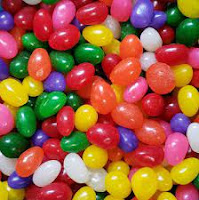In this special Easter episode, the Jelly Bean . . .
Today many youngsters and the young at heart will scour their yards for Easter eggs and Jellybeans left by the Easter Bunny. Have you ever wondered just what it takes to make a jelly bean? An interesting fact from one of my morning newsfeeds, the Interesting Facts Newsletter, described by industry giant Jelly Belly explains.
The process begins by heating a sugar, cornstarch, corn syrup, and water mixture, known as a slurry, and adding fruit purée, juice concentrate, and other ingredients for flavoring. From there, the mixture is squirted into cornstarch-coated molding trays and left to solidify into the chewy jellybean centers. The following day, the bean centers are sent through a steam bath and a sugar shower to keep them from sticking. They are then loaded into a spinning machine for a process known as "panning," in which sugar and syrup are manually applied over two hours to build each bean's candied shell.
Following another settling period, the candies receive an additional syrup coating before being polished with confectioner's glaze and beeswax. Upon earning a final thumbs-up through visual inspection and spot taste-testing, the beans are stamped with the Jelly Belly logo and shipped out into the world.
It's a lot of showering, rinsing, resting, and repeating, a process that takes seven to 14 days to complete. And while that might seem like an outsized increment of time for such a tiny edible, the Americans who gobble down an average of 16 billion jelly beans every Easter seem to think it's worth it.
Well, there you have it. So, get out, dawn your new spring outfit, have your sunrise service, meet your friends, dye a few eggs, and have a Jelly Bean or two on me. Oh, don't forget to look around for that chocolate bunny.
I'm Patrick Ball; thanks for listening; see you in the next episode.

Comments